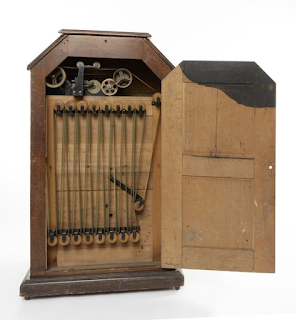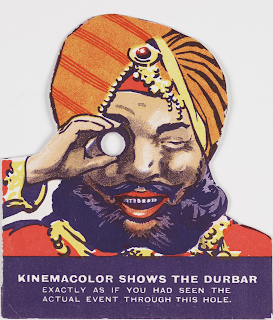Cinematography is the illusion of movement by the recording and subsequent rapid projection of many still photographic pictures on a screen. Originally a product of 19th-century scientific endeavour, cinema has become a medium of mass entertainment and communication, and today it is a multi-billion-pound industry.
 |
| Publicity image of Edison Kinetophone, c.1895 |
Who invenred cinema
No one person invented cinema. However, in 1891 the Edison Company successfully demonstrated a prototype of the Kinetoscope, which enabled one person at a time to view moving pictures. The first public Kinetoscope demonstration took place in 1893. By 1894 the Kinetoscope was a commercial success, with public parlours established around the world.
 |
| Detail of Kinetoscope, made by Thomas Edison in 1894 |
The first to present projected moving pictures to a paying audience were the Lumière brothers in December 1895 in Paris, France. They used a device of their own making, the Cinématographe, which was a camera, a projector and a film printer all in one.
 |
| Lumière Cinématographe, c.1896 |
What were early films like
At first, films were very short, sometimes only a few minutes or less. They were shown at fairgrounds, music halls, or anywhere a screen could be set up and a room darkened. Subjects included local scenes and activities, views of foreign lands, short comedies and newsworthy events. The films were accompanied by lectures, music and a lot of audience participation. Although they did not have synchronised dialogue, they were not ‘silent’ as they are sometimes described.
 |
| Frames of stencil colour film |
The rise of the film industry
By 1914, several national film industries were established. At this time, Europe, Russia and Scandinavia were the dominant industries; America was much less important. Films became longer and storytelling, or narrative, became the dominant form. As more people paid to see movies, the industry which grew around them was prepared to invest more money in their production, distribution and exhibition, so large studios were established and dedicated cinemas built. The First World War greatly affected the film industry in Europe, and the American industry grew in relative importance. The first 30 years of cinema were characterised by the growth and consolidation of an industrial base, the establishment of the narrative form, and refinement of technology.
 |
| Kinema color cine camera made by Moy and Bastie 1909 |
Adding colour
Colour was first added to black-and-white movies through hand colouring, tinting, toning and stencilling. By 1906, the principles of colour separation were used to produce so-called ‘natural colour’ moving images with the British Kinemacolor process, first presented to the public in 1909.
 |
| Advertisement for "With our King and Queen through India" 1912 |
Kinemacolor was primarily used for documentary (or ‘actuality’) films, such as the epic With Our King and Queen Through India (also known as The Delhi Durbar) of 1912, which ran for over 2 hours in total.
 |
| Advertisement for Kinemacolour 1911 |
The early Technicolor processes from 1915 onwards were cumbersome and expensive, and colour was not used more widely until the introduction of its three‑colour process in 1932. It was used for films such as Gone With the Wind and The Wizard of Oz (both 1939) in Hollywood and A Matter of Life and Death (1946) in the UK.
 |
| Technicolor cine camera |
Adding sound
The first attempts to add synchronised sound to projected pictures used phonographic cylinders or discs. The first feature-length movie incorporating synchronised dialogue, The Jazz Singer (USA, 1927), used the Warner Brothers’ Vitaphone system, which employed a separate record disc with each reel of film for the sound. This system proved unreliable and was soon replaced by an optical, variable density soundtrack recorded photographically along the edge of the film, developed originally for newsreels such as Movietone.
 |
| Vitaphone disc, 1930. |
Cinema's golden age
By the early 1930s, nearly all feature-length movies were presented with synchronised sound and, by the mid-1930s, some were in full colour too. The advent of sound secured the dominant role of the American industry and gave rise to the so-called ‘Golden Age of Hollywood’. During the 1930s and 1940s, cinema was the principal form of popular entertainment, with people often attending cinemas twice a week. Ornate ’super’ cinemas or ‘picture palaces’, offering extra facilities such as cafés and ballrooms, came to towns and cities; many of them could hold over 3,000 people in a single auditorium. In Britain, the highest attendances occurred in 1946, with over 31 million visits to the cinema each week.
 |
| Cinema audience, 1932, James Jarché. |
 |
| Installation of IMAX screen at the museum, 1983. |




No comments:
Post a Comment